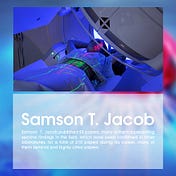Over the past 20 years, cancer research has expanded significantly. This has led to new ways to diagnose and treat conditions and illnesses that didn't have many options before. Dr. Samson Jacob's research team made a significant contribution to this project. He has studied liver cancer and some kinds of leukemia, especially chronic lymphocytic leukemia. He has been considered a leader in this field for a long time.
He always knew that he wanted to work in the medical field, but he also knew it would take a lot of time and work. Still, he worked hard and took on significant leadership roles at some of the best colleges in the country. Finally, he decided to keep working toward becoming a researcher while also starting to teach in a medical school because he wanted a career with many different parts.
Dr. Jacob got his post-doctoral training at Baylor College of Medicine in Houston, Texas, before he started working at MIT to teach and do research. Since then, he has strongly desired to learn more about things.
From the start, he knew that he would have to work twice as hard to make a big difference in science.
After being named Assistant Professor at MIT in 1969, the Damon Runyon Foundation gave him money to do research in 1970. At the time, the NIH grant was a very sought-after award. During the 50 years that Dr. Jacob worked, he was in charge of at least one federal budget. In 1972, he got a job as an Associate Professor in the Department of Pharmacology at the Pennsylvania State University College of Medicine. Four years after that, he was given the title of Tenured Professor. After 18 years at Penn State, Dr. Jacob retired and became the chair of the pharmacology and molecular biology department at the Chicago Medical School, which is now part of Rosalind Franklin University of Medicine and Science. In 1996, Dr. Jacob joined the Ohio State University College of Medicine (now called Wexner Medical Center), in Columbus, Ohio, as the Department of Medical Biochemistry Chair. He was a dedicated professor at OSU, working for 20 years in different roles. He was co-director of the Experimental Therapeutics Program and the first director of the Comprehensive Cancer Center's Intramural Research Program. He worked hard, which paid off when he got the first significant grant for a program project as a Principal Investigator in a primary science department. Also, they raised the department's NIH ranking by almost 20 points in just three years.
